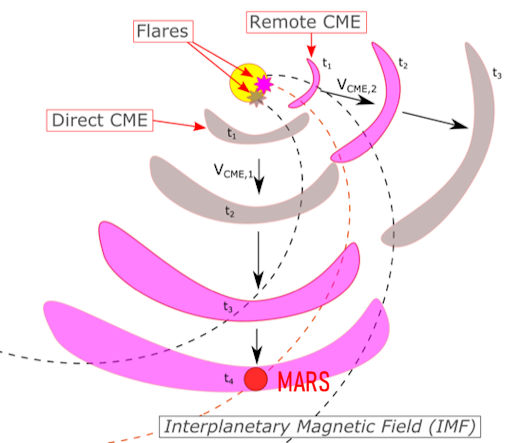Every planet has auroras because every planet has a magnetosphere because every planet has their own timing coordinates for their evolution to keep them on the cosmic circuits. This is axiomatic.
It’s only on earth that people have no clue about their proper timing coordinate because of the extraordinary evil heisting all of our energy dating back thousands of years. The combination of religion, government, and tech is trying to kill off humans, yet we persist.
The Feds Report
GEOMAGNETIC STORM WATCH (G1): One or more CMEs could graze Earth on April 26-27, sparking a minor G1-class geomagnetic storm. The CMEs were hurled into space earlier this week by explosive activity in sunspot super-group AR3638-50. CME impact alerts: SMS Text
GLOBAL AURORAS ON MARS: Earth isn’t the only planet with auroras. Mars has them, too–on a global scale.
“Mars is experiencing its greatest level of auroral activity in the past 10 years,” says Nick Schneider of the University of Colorado’s Laboratory for Atmospheric and Space Physics (LASP). “In February alone, there were three episodes of global auroras–an ‘aurora hat trick’ we’ve never seen before.”
Orbiting high above Mars, NASA’s MAVEN spacecraft recorded the auroras on 3-4 Feb, 7-10 Feb and 15-16 Feb. This animation shows the last two of these episodes in a looping time series:
Spaceweather.com actually predicted some of these events, prompted by SOHO coronagraph observations of CMEs heading toward Mars. “Your predictions came true!” says Schneider.
Schneider leads the team for MAVEN’s Imaging Ultraviolet Spectrograph (IUVS), the instrument that detected the auroras. All the purple pixels in the animation are a false color representation of the aurora’s ultraviolet glow. Martian auroras probably have a visible light component, too, but MAVEN’s cameras are not able to see them.
Here on Earth we would love it if auroras were global. Seeing Northern Lights with equal ease from the equator and the poles would check off a lot of bucket lists. Be careful what you wish for, though. Martian auroras can be global because the Red Planet has almost no protection from solar storms. It lacks an Earth-like magnetic field, so particles from the sun penetrate its atmosphere with ease–everywhere.
The dramatic auroras of February 2024 were caused by “SEPs”–solar energetic particles. SEPs are accelerated by shock waves within approaching CMEs. When they strike Mars’s atmosphere, they cause it to glow.

“Mars is currently getting hit by roughly 1 to 2 CMEs every month, bringing a hefty supply of SEPs,” says Rebecca Jolitz, a member of the MAVEN Solar Energetic Particle (SEP) instrument team at UC Berkeley’s Space Sciences Lab. “However, a CME doesn’t actually have to hit to be effective. SEPs coming in sideways from ‘remote CMEs’ can light up the skies as well.”
Schneider and Jolitz are looking forward to the months ahead. “Solar Cycle 25 is far from over, and we expect many more CME strikes,” Schneider says. “This will give us a chance to study how solar storms affect the atmosphere of Mars–a key goal of the MAVEN mission. It’s the kind of fun we’ve been waiting for!”
Extra: Schneider notes that SEPs aren’t the only way to make auroras on Mars. Protons in the solar wind and magnetic reconnection can do the trick, too, producing their own forms and colors. Stay tuned for more stories about the rich variety of Martian auroras as Solar Cycle 25 unfolds.

